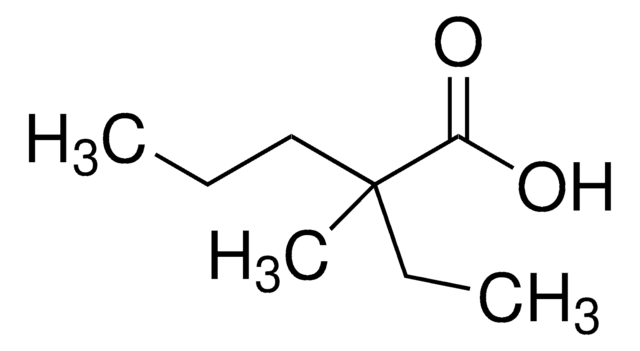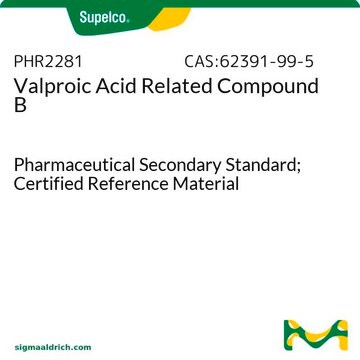Kluczowe dokumenty
Y0001422
Valproic acid for system suitability
European Pharmacopoeia (EP) Reference Standard
Synonim(y):
2-Propylpentanoic acid, Valproic acid
About This Item
Polecane produkty
klasa czystości
pharmaceutical primary standard
rodzina API
valproic acid
producent / nazwa handlowa
EDQM
współczynnik refrakcji
n20/D 1.425 (lit.)
bp
220 °C (lit.)
gęstość
0.9 g/mL at 25 °C (lit.)
Zastosowanie
pharmaceutical (small molecule)
Format
neat
temp. przechowywania
2-8°C
ciąg SMILES
CCCC(C(O)=O)CCC
InChI
1S/C8H16O2/c1-3-5-7(6-4-2)8(9)10/h7H,3-6H2,1-2H3,(H,9,10)
Klucz InChI
NIJJYAXOARWZEE-UHFFFAOYSA-N
informacje o genach
human ... ALDH5A1(7915)
Szukasz podobnych produktów? Odwiedź Przewodnik dotyczący porównywania produktów
Opis ogólny
Zastosowanie
Działania biochem./fizjol.
Opakowanie
Inne uwagi
Hasło ostrzegawcze
Danger
Zwroty wskazujące rodzaj zagrożenia
Zwroty wskazujące środki ostrożności
Klasyfikacja zagrożeń
Acute Tox. 4 Oral - Eye Dam. 1 - Repr. 1A - Skin Irrit. 2
Kod klasy składowania
6.1C - Combustible acute toxic Cat.3 / toxic compounds or compounds which causing chronic effects
Klasa zagrożenia wodnego (WGK)
WGK 3
Temperatura zapłonu (°F)
231.8 °F - closed cup
Temperatura zapłonu (°C)
111 °C - closed cup
Wybierz jedną z najnowszych wersji:
Certyfikaty analizy (CoA)
It looks like we've run into a problem, but you can still download Certificates of Analysis from our Dokumenty section.
Proszę o kontakt, jeśli potrzebna jest pomoc Obsługa Klienta
Masz już ten produkt?
Dokumenty związane z niedawno zakupionymi produktami zostały zamieszczone w Bibliotece dokumentów.
Klienci oglądali również te produkty
Nasz zespół naukowców ma doświadczenie we wszystkich obszarach badań, w tym w naukach przyrodniczych, materiałoznawstwie, syntezie chemicznej, chromatografii, analityce i wielu innych dziedzinach.
Skontaktuj się z zespołem ds. pomocy technicznej









